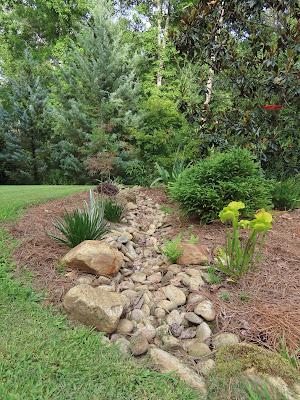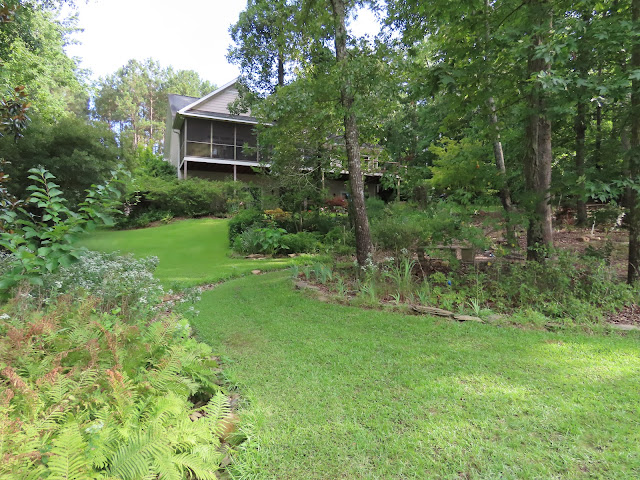Time sure flies! In 2010 we moved to South Carolina from Virginia. If I were to have to guess, I would say it was only 5 or 6 years! Wow. I hadn't done a yearly review of the yard/gardens for a couple years. Here are a few links to previous posts with photos of progress. I will just share this year's photos today.
Over the years we added a dry creek bed through the backyard, I highly recommend one if you have run-off in your yard that you want to direct. I added a short dry creek bed in the front yard to help with the mulch getting washed downhill. Our lake front area is a mess. I had it redone a few years ago with Hayscented ferns Dennstaedtia punctiloba, Panicum virgatum 'Shenandoah', and four Podocarpus macrophyllus 'Pringles Dwarf'. The ferns needed more water in some areas, the grasses didn't thrive like they should and the Pringles were eaten by the deer. The irrigation wasn't working like it should have. I had it set to go off in the wee hours of dawn, only to find an error code for valve one- the largest section of the yard. Now I manually start the sprinklers and they work fine. Not sure what the issue was. Finally, there was also a tree that fell onto the bank- crushing some of the grasses and ferns. I won't share that area today... maybe another time.
 |
| Front garden |
The front garden is filled with four Drift Roses 'Popcorn', one Loropetalum 'Purple Pixie', Cercis canadensis 'Ruby Falls' Redbud. Multiple Calla lilies, Zantedeschia albomaculata, have reseeded, a volunteer fern, Thelypteris normalis, popped up by the downspout pop-up and there's plenty of Sedum rupestre 'Angelina' and Dianthus 'Firewitch' spreading along the sidewalk.
The shed is almost hidden because of all the shrub growth. At the corner of the shed is a large Tea Olive, Osmanthus fragrans.
The front yard from the other direction. In the small garden, in the photo above is Prunus mume 'Hokkia-bungo' which just shines in December and January. On a warm day the honey bees are all over the blooms, happy to have something blooming at that time of year. Groundcover along the driveway in that garden is Hypericum caylcinum 'Brigadoon'. In the photo below, you can get a better view of the newest garden. A few years ago I decided to mulch the center of the front yard and put in a pollinator garden. The armadillo population and I have a running battle with the plants in that garden. I say they should stay, the armadillo thinks there might be good eats under those plants. To protect the center of the garden I have a small garden fence/edging. In this mulched area I have four Japanese maples- Red Dragon, Butterfly, Virdis, and Crimson Queen. Inside the almost invisible barrier is a selection of Rudbeckia, Echinacea, Iris, Asclepias, Stokesia aster, Cranesbill Geranium, Vernonia, Penstemon, and Agastache. Anchoring the center of the large garden is Magnolia grandiflora 'Little Gem'. After being hit by a falling pine in a ice storm it has rebounded nicely.
When I put in this large mulched bed, I had a washout of mulch. I finally ended up digging a trench and making my little dry creek bed. Hardwood mulch washes downhill too easily, so I changed it to be a pine straw mulch. Part way down the hill, in the bed, is a Crypotmeria globosa 'Nana', a really nice evergreen. Dotted along the edge of the rocks of the creek bed I planted a few Pitcher plants, Sarracenia flava. The one at the top of the hill I put a berm behind it to keep water at the plant's roots for a bit longer than if there was no berm. I have had success with them in the garden so I am going to get some of the other species.
From the front yard we will walk around the house on the low side to the back. It is almost like tunnel to get to the back. The wax myrtles, Morella cerifera, are now small trees. They needed to be limbed up or given a rejuvenating cut (to the ground). I like the small fruit available for the birds, so they got limbed up. On left as we walk through the tunnel is a nice sized blue hydrangea, Hydrangea macrophylla, the deer seem to leave this one alone. shhhh, don't tell them it is here. In the lower left corner is a Swamp Sunflower, Helianthus angustifolius still small, thanks to the deer. Behind the sunflower is my very tall Calycanthus sp. I would call it a small tree, not a shrub!
The backyard--
from below- Looking back up to the house. This is the garden area that lacked water last year, so I have some replanting to do both this fall and next spring. These mature trees soak up all the available water.
You can see the dry creek bed cut across the lawn area. It curves around the gardens and works well.
Turning around to the lake you see my biggest stand of mountain mint, Pycnanthemum muticum. The pollinators love it. All day long it is covered with various bees and wasps as well as butterflies. It is a mint, so it needs to be kept in bounds. In this garden it competes with ostrich fern, Matteuccia struthiopteris, who will win?
The garden has so many mature trees, mostly oaks and hickory. I was challenged by some fellow gardeners at the Fling to count my trees. Maybe that will be a winter project.
Thanks for joining me on a walk around the yard after twelve years in one place. Additions and subtractions will be coming in the following year(s).


























